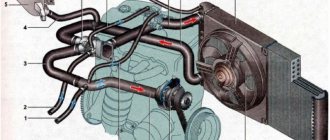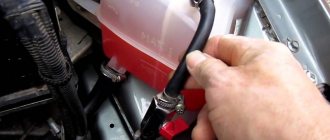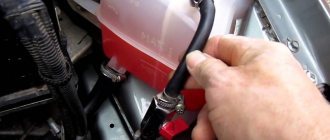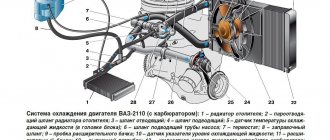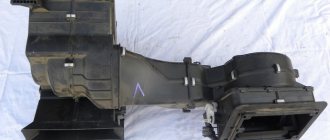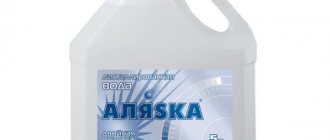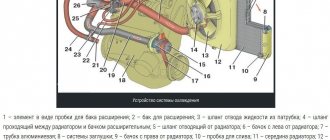Before you start doing anything with SOD, it is advisable to read the main points in this FAQ!
Important information about Kalina-1 SOD is here: https://www.lkforum.ru/showthread.php?t=41258
Diameters of hoses for the entire SOD (internal/external):
Heater radiator inlet hose (upper): 20 mm / 28 mm Heater radiator outlet hose (lower): 18 mm / 28 mm Throttle assembly heating hose (both): 10 mm / 19 mm Expansion tank hose (lower) - 20 mm / 28 mm Engine radiator steam removal hose - 8 mm / 14 mm Fluid supply hose to the engine radiator (upper) - 32 mm / 42 mm Fluid drain hose from the engine radiator (lower) - 36 mm / 46 mm Coolant pump supply pipe hose (bypass) – 32 mm / 42 mm
If you can’t go where you want, go where you can ©
| vovk user menu |
| View profile |
| Find more posts by vovk |
| Read the diary |
I found some good looking reinforced hoses for sale Semperit TU 25 Oil/Air PN 25bar Made in EU
(in a simple rubber goods store opened in the USSR). Now we need to understand whether antifreeze will corrode them.
Please tell me, is it possible to heat antifreeze to a boil (on gas)? Will the purity of the experiment be affected? Is it enough to boil a piece of hose in antifreeze once?
| 15.11.2016, 14:45 | #421 |
| SVSan user menu |
| View profile |
| Find more posts by SVSan |
I found some good looking reinforced hoses for sale Semperit TU 25 Oil/Air PN 25bar Made in EU
(in a simple rubber goods store opened in the USSR). Now we need to understand whether antifreeze will corrode them.
Please tell me, is it possible to heat antifreeze to a boil (on gas)? Will the purity of the experiment be affected? Is it enough to boil a piece of hose in antifreeze once?
A side effect of the operation of an internal combustion engine is heat; it is released due to the combustion of the combustible mixture when interacting with rubbing surfaces. If you do not take measures to remove heat from very hot parts, the entire motor will soon fail. Heat removal in water-cooled motors is carried out using coolant. The circulation pump moves fluid from the cylinder block to the radiator. The thermostat is responsible for quickly warming up to operating temperature; it separates two circuits (small and large). Separating the circuits serves to quickly heat the motor to operating temperature and prevent overheating. To prevent the liquid from boiling, the pump creates pressure in the cooling system. If everything is in order, then during normal operation it is impossible to overheat the power plant even on a summer day. If the temperature gauge needle is in the red zone, you should immediately check all components and mechanisms to avoid failure of the power plant.
Technical features of the system
The unified layout and closed design of the engine cooling system (SOD) of the Kalina are also characteristic of other VAZ models. The system is designed to remove thermal energy from heated engine elements using antifreeze or other coolant.
The SOD consists of the following functional parts.
- Cooling radiator. Reduces coolant temperature due to the flow of cold air masses.
- Fan. Used for rapid cooling of antifreeze in the Kalina cooling system.
- Expansion tank. Designed to compensate for the volume of coolant (coolant). The need for this unit is related to the expansion/constriction property of the coolant.
- A pump or centrifugal pump, which is responsible for the forced circulation of antifreeze through the appropriate channels.
- A thermostat whose task is to regulate the volume of antifreeze in the Kalina cooling system.
- Temperature sensor involved in SOD control.
The operation of the cooling system is based on the close interconnection of various parts, elements and sensors, including devices that are designed to measure oil temperature. The passage of coolant in a large or small circle depends on the engine temperature. In the first case, antifreeze passes through all components of the SOD, except the radiator. With such circulation, the thermostat is closed. As the engine temperature rises, this element gradually opens. The antifreeze, having passed a large circle, enters the radiator. The latter device is cooled by oncoming air masses. If this is not enough, a signal is sent to the ventilated unit, which begins to forcibly direct air masses to the cells.
The cooled liquid enters a small circle. Next, taking into account the engine temperature, the antifreeze automatically circulates in a small or large circle. At the same time, the optimal operating temperature is maintained, which should be in the range of 95-105°C. This factor has a direct impact on the performance of the Kalina stove. In this case, it will not be able to supply warm air masses into the cabin.
If there are any doubts about the operation of the ODS, you need to diagnose the car, finding out the causes of the malfunction. You can fix the breakdown either with your own hands or with the help of a car mechanic.
First, it is recommended to check the antifreeze level in the system. To do this, you will need to open the hood and inspect the expansion tank. It should be filled to 1/2 of the total volume. If necessary, antifreeze is topped up or the coolant is completely replaced. In the latter case, you will need to drain the old antifreeze. If there is a fluid leak, you need to inspect the engine compartment.
How to install a thermostat for a Lada Granta on Kalina
Car owners do not need to explain what the cooling system of an internal combustion engine is and how important it is. But since the topic concerns this component, without which not a single power unit can operate, and those who are only dreaming of purchasing a car can read the article, we will briefly talk about the design and operating principle of the cooling system.
Engine cooling system
The internal combustion engine must be intensively cooled. Without this, the unit will overheat and jam. The bulk of the “cooling energy” is required by the cylinder head and block. While small power engines can be cooled using an air flow, more powerful, multi-cylinder power plants cannot be brought to an optimal temperature without using a liquid cooling system.
It includes:
- a cooling jacket through which liquid flows, taking away excessive heat from the cylinders;
- a pump that forces antifreeze to move through the cooling system;
- a thermostat that regulates the temperature by adjusting the flow of coolant in a small or large circle;
- fan and radiator, causing the liquid to cool faster as it moves around a large cooling circle;
- heater radiator that heats the interior of the car;
- connecting hoses and pipes connecting all devices into a single cooling system.
As mentioned above, the thermostat is responsible for movement in a large or small circle. This device is a spring-loaded valve with a thermocouple placed in a housing with several pipes. Under the influence of high temperature, from +85 °C to +90 °C, the technical paraffin contained in the thermoelement expands and opens the valve. Antifreeze begins to flow through the opened hole in a large circle, cooling in the radiator. When the liquid cools, the valve falls into place and the coolant stops flowing into the large circle.
And the story will be about replacing the thermostat of a Lada Kalina car with a thermostat from a Lada Granta.
Why change the Kalina thermostat to a Grantovsky device?
There can be only two reasons why the original thermostat installed on the Kalina is replaced with a device from Grant:
- Firstly, this is engine overheating when the power plant temperature needle is around +100 °C. This mode of operation can lead to jamming of the pistons.
- Secondly, there is insufficient heating of the interior in winter. In addition to the fact that it is uncomfortable to be in a cold car interior, this also causes the windows to freeze and you have to drive blindly. And this is a real danger to life.
This is due to the fact that the standard cooling system of the LADA Kalina does not know how to “de-air” itself. That is, if air gets into the small cooling circle, it will no longer be removed from the system. The process grows like an avalanche, air will continue to be sucked in constantly. This leads to the fact that the coolant does not flow to the radiator, the engine overheats, and cold air blows from the stove. The problem is solved by installing a thermostat from LADA Granta. As the owners of Kalina, who decided to take such a step, say, after reinstalling the thermostat, all problems were solved: the cabin became warm, and the engine temperature did not rise above +90 ° C.
What is needed to reinstall the thermostat from Grant to Kalina
To bring the Kalina engine cooling system to optimal condition you will need:
- Thermostat. You can easily pick it up at a car dealership with the help of consultants. However, please note that some models have a fitting for heating the throttle device, while others do not. It is better to take it with a fitting, otherwise you will have to perform additional operations to connect the heating hose to the stove pipe.
- Some experts recommend changing the thermal insert on the Grant device. Supposedly this improves the operation of the thermostat. Others say it's a waste of time and money. If you wish, you can buy a thermocouple, for example, from. The fact that the device will be of this particular brand is not important. You can use thermal inserts from other manufacturers. The main thing here is characteristics and quality. Since the thermal insert assembly will not fit the thermostat from the Grant, you will need to remove the thermoelement from it. This can be done using a hacksaw for metal.
- In addition to the above, to rearrange the thermostat you will need two studs from the camshaft bed of the “classic”: from VAZ-2101 to VAZ-2107. These fasteners will be needed to secure the Grant thermostat to the Kalina engine. Standard studs will not fit, since the size of the element being installed differs from that installed at the factory.
- Stove pipes. In principle, their replacement may not be necessary. But practice shows that a long service life leads to the fact that it is better to replace them once work has begun on the cooling and heating system. You will also need a tee, which will need to be cut into the lower pipe of the stove.
- Lower radiator pipe from LADA Granta.
- Expansion tank pipe. It fits both Grant and the “ten”.
- Sealant, clamps and gaskets.
Once everything is prepared, you can proceed to installing the new thermostat. But for this it is still necessary to carry out preparatory measures.
Preparing to install the thermostat
First you need to remove the standard Kalina thermostat. Before this, the battery, air filter and pipe leading to the gas throttle are removed. Having finished with the air filter, begin to drain the antifreeze from the cooling system. It is better to place a basin under the engine, so the coolant will not spill.
After loosening the clamps, remove all pipes from the thermostat. Then they begin to unscrew the nuts on the studs. Unscrew the nuts and remove the thermostat. This completes the procedure for dismantling the old device. Preparations begin for installing the thermostat from the Granta car. To do this, you need to unscrew the old studs. This is easy to do with a hairpin driver, but if you don’t have such a wrench, you just need to screw a nut onto the hairpin, and then another one. Pull them tightly and unscrew them using a regular wrench. After removing the old studs, clean the thermostat installation site from old sealant and gasket residues. This is where the preparation ends.
Installation of a thermostat from Grant
Before installing a new temperature-maintaining device, the studs from the camshaft of “classic” VAZ models are screwed in. All heels have triangular cutouts at one end. This is how manufacturers mark the end that screws into the engine block. Sealant is applied to the junction of the thermostat and the engine and a gasket is installed. The following installation steps:
- The thermostat is mounted on studs and screwed with nuts.
- A pipe is removed from the lower outlet of the stove in order to insert a tee into it, another outlet of which will be connected by a pipe to the expansion tank.
- After completing this procedure, the pipe is put in place, connecting the thermostat and the stove. A pipe leading to the expansion tank is put on the outlet of the tee and secured with a clamp. Air will be removed from the cooling system through it.
- A Grant hose is installed, running from the lower radiator pipe to the thermostat. It fits almost perfectly, so there is no need to lengthen or shorten anything.
- All that remains is to secure all the pipes with clamps, install the air filter, battery and add antifreeze.
If everything is done correctly, the engine will stop heating and will not raise the temperature needle close to critical values. And the car interior will be warm, even in the coldest weather.
The main causes of ODS malfunctions
Coolant leakage is mainly due to the following reasons:
- presence of an old clamp;
- old or broken radiator.
In the first case, the unit is replaced, and in the second, repairs are carried out.
First of all, check the system pipes
Then you will need to check the circulation of fluid in the motor system in question. To do this, you need to see if antifreeze is entering the tank. If the result is negative, then replace the pump or clean the cooling system with special means.
If the Lada Kalina overheats, auto mechanics identify the following reasons for this situation.
- The thermostat has failed. To check its functionality, you need to touch the radiator pipes. If the top element is cold and the bottom element is warm, the thermostat is stuck. In this case, a new unit is installed.
- Clogged honeycombs. This problem usually occurs in late spring and early summer. In such a situation, clean the outer part of the radiator.
- Fan malfunction. If this device does not turn on when the coolant temperature is high, you need to check the wiring and relay.
- Presence of air masses in the SOD.
To solve the last problem, you will need to open the expansion tank. Start the engine, periodically press the gas pedal until the red mark is reached on the sensor. If the fan turns on, then you need to “add gas” by turning off the ignition. If it is not possible to eliminate the airlock using this method, more radical measures are used.
The plastic motor screen will need to be removed. To do this, he rises. Use a screwdriver to lower the clamp. Remove 1 of the 2 fitting tubes. Then remove the expansion tank cap. You need to blow into the container until antifreeze begins to pour out of the dismantled tube.
If it is not possible to break through the container, the lid closes. The tube is put in place. The engine warms up and the ignition turns off. Without dismantling the tank lid, remove the heating tube.
How to troubleshoot your cooling system yourself
If you notice that a stream of cold air is entering the cabin, you should not delay repairs, especially if the autumn-winter period is upon us.
Fixing improper cooling can be done in several ways. Car enthusiasts recommend following step-by-step instructions on the forums:
- Remove the hose from the part responsible for heating the throttle assembly.
- Open the expansion tank cap and place a clean, dry cloth on top of the neck.
- Blow into the tank.
- Monitor the progress of the antifreeze. As soon as the coolant appears on the horizon, quickly return the hose to its original place and tighten tightly with a clamp.
Why might this method be dangerous? Coolant is a toxic solution and must be handled with extreme care, so to prevent the substance from spilling, it is advisable to enlist the help of a friend who will help you quickly install the hose. In addition, antifreeze is hot and can burn your hand.
Another option for combating the airing of the cooling system in the Lada Kalina from folk craftsmen, it is more reliable:
- Wait until the engine has completely cooled down. Remove the hose from the expansion tank. It is mounted close to the rest of the components of the Lada Kalina cooling system.
- Pour liquid into the antifreeze reservoir to the maximum possible level and screw the cap tightly.
- Place the hose in an empty container up to 5 l. Place a hose coming from the air pump unit onto the tank nozzle; the latter is intended for inflating Lada Kalina tires.
- Use a pump to pump up the pressure in the tank, so that the coolant will move freely into the prepared canister.
- Do not take your eyes off the reservoir, otherwise the liquid may overflow. If, on the contrary, it is not enough, antifreeze should be added to the required value.
- When the liquid is completely added, put all existing connections back in their original places.
Important points of improvement
Coolant is considered a toxic substance that adversely affects human health. Auto mechanics recommend draining antifreeze with caution. When carrying out this procedure, you need to remember safety precautions and use rubber gloves. The antifreeze is drained when the engine is cold. Then the tube is put on the fitting, the clamps are tightened. Air masses have been successfully removed from the system under consideration.
What's the result?
Taking into account the above information, it becomes clear that if the stove does not heat or the engine overheats, the Kalina thermostat is not always the cause of the problems. Of course, when such symptoms appear on Kalina, the thermostat and coolant level should be checked first. However, it often happens that the thermostat is working, as well as the antifreeze level is normal.
In this case, the cause is precisely air locks. Moreover, attempts to “expel” air from the engine cooling system using standard methods often do not yield results. For this reason, improvements to the system itself are necessary to eliminate the possibility of an air lock forming in the future.
Finally, we note that the only disadvantage of the method of improving the Kalina SOD discussed above is that the engine may take longer to warm up. Moreover, against the background of the problems that arise when the standard system is aired (overheating of the internal combustion engine, cold stove, etc.), such a drawback practically does not manifest itself at all, even in the cold season.
Sources
- https://xn—-8sbabr6ahc3e.xn--p1ai/kalina-remont/192-ustroistvo-sod-kalina.html
- https://avtodvigateli.com/detali/sistema-oxlazhdeniya-kalina-8-klapanov.html
- https://expertVAZ.ru/lada-kalina/zamena-zhidkosti-sisteme-oxlazhdeniya.html
- https://carfrance.ru/polnaya-sxema-sistemy-oxlazhdeniya-dvigatelya-lada-kalina/
- https://FB.ru/article/139510/kalina-sistema-ohlajdeniya-neispravnosti-i-usovershenstvovaniya
- https://remam.ru/vozdsys/dorabotka-sistemy-ohlazhdeniya-lada-kalina.html
- https://Vaz-Lada-Granta.com/kalina/motor-i-korobka/sistema-ohlazhdeniya.html
- https://ladaautos.ru/lada-kalina/prichiny-zavozdushivaniya-sistemy-oxlazhdeniya-lady-kalina-i-dorabotka.html
- https://KrutiMotor.ru/sistema-ohlazhdeniya-kalina-dorabotka-sistemy-ohlazhdeniya-lada-kalina/
Cooling system Lada Kalina: features
The operating temperature of the Kalina engine is up to 103°.
If the temperature is higher, the engine overheats, which means that the driver and his car will face serious troubles: head deflection or (even more depressingly) water hammer.
Overheating of the motor is possible in a situation where one or another cooling element fails. At first, a light phase begins - during which the engine begins to boil.
The consequences may be even more severe. They are characterized by deformation and deflection of the cylinder head. In this case, the situation can be corrected by simply grinding the surface of the latter.
The middle phase is characterized by deformation of engine parts of the same valve mechanism. In the future, the above-mentioned part will require serious repairs: after all, repairing the cylinder head is quite a financially expensive matter.
The heavy phase represents destruction from the strong heat flow of the piston group. Still, this defect is not the worst thing you can expect. But if coolant gets into the car cylinders, the power unit of your car will quite naturally suffer a water hammer. And then a major overhaul may not help.
Symptoms of problems
There are a number of symptoms that indicate a malfunction of the cooling system; if at least one of them is detected, it is worth taking corrective action.
- When the engine is not started and has cooled down (more than 8 hours of inactivity), a residual pressure remains in the cooling lines (this can be understood when the rubber pipes are pressed, they will be hard).
- The release of coolant when the engine is running can be either a small amount or a significant column of steam.
- Coolant leakage from lines or radiators is accompanied by a decrease in the coolant level in the tank.
- When the engine is fully warmed up, cold air blows from the deflectors coming from the cabin heater. The effect may disappear when the crankshaft speed increases.
And if with the first three points everything is more or less clear, then with the last it’s not so simple. You can change radiators, thermostats and coolant as much as you like, but you still won’t achieve a positive result. The problem is the formation of an air lock that cannot be seen. The air in the lines prevents the normal removal of heat from highly heated parts, which can lead to serious damage to the power plant.
Functional range of elements of a car cooling system
The standard cooling system consists of the following elements:
- sensors – determine t° in certain auto mechanisms; one of the management elements of the system;
- pump – makes it possible to circulate liquid in the SOD; operates in a forced mode;
- pipes – coolant moves through them;
- expansion tank - compensates for the volume of antifreeze, since due to temperature fluctuations it narrows and expands;
- radiator - a device that discharges excess heat into the environment;
- fan – activates the cooling process by forcing air; With its help, the cooling intensity increases;
- Thermostat - although small, is a very important element that regulates the amount of antifreeze; provides a “comfortable” temperature regime throughout the entire system.
Operating principle
The cooling system operates in a self-regulating mode, which is aimed at maintaining optimal temperature in the power unit. If the oil temperature rises significantly, the system does everything to ensure that the temperature inside the engine decreases.
Thus, with the close interaction of the above elements, the system functions. It automatically sets the necessary conditions for the inclusion and operation of structural parts, which ensures effective cooling of the power unit.
Design elements
The expansion tank of the Lada Kalina car is made of transparent polyethylene. The system in question is sealed due to the presence of inlet and outlet valves. The SOD scheme in Kalina provides for the presence of a coolant pump. The device body is made of aluminum. There is a control hole inside the unit, which can be used to detect fluid leakage if the pump breaks down.
The engine cooling system of the Lada Kalina car consists of 2 circulation circles:
- the liquid moves through the jacket and radiator (large circle);
- the liquid moves only along the jacket (small circle).
Possible malfunctions of the ODS, diagnostics
Almost always, a breakdown of the cooling function of a car is caused by an antifreeze leak. You should inspect the car under the hood for possible leaks. The cause of the leak may be:
- or a leaky clamp;
- or a radiator failure.
Then in the first case the element is replaced; this is not difficult and does not take long. As for the radiator, it is better to have it repaired. There are also no particular difficulties here: often you just need to solder the holes.
The reasons for overheating of this car can also be:
- thermostat. Its suitability is checked using both pipes: the temperature of the latter should not be sharply different (this is determined on a warm engine). Otherwise, the thermostat is faulty and antifreeze circulates in a small circle;
- clogging of radiator honeycombs. You can solve the problem by cleaning the outside of this element. Often this is not always easy to do, but there are no other methods other than manually cleaning the honeycombs;
- Fan malfunction. When the heating level of the coolant increases, this part should begin to operate. If this does not happen, check the relay, wiring or t° sensor;
- air in the coolant system. Lada Kalina is not insured, among other things, against the so-called air lock inside the system. In general, previous types of breakdowns are eliminated quite quickly and almost everything is clear with them. In the latter case, it is necessary to understand in more detail. The question - how to remove air from the Kalina cooling system - is really very important for the optimal functioning of the totality of the elements of this car.
Airlock
If the cooling system becomes airy, you need to do the following: with the expansion tank cap open, start the power unit, squeezing the gas pedal from time to time, warm it up until the t° sensor “reaches” the red scale. After “starting” the ventilation device, “add up the gas” a little more and then you can turn off the ignition.
If the cooling system is still leaking air and the above measures have not led to anything, you should act more radically. What needs to be done to remove air from the cooling system?
First, remove the power motor screen (dismantling is done in an upward direction).
Loosen the clamp with a screwdriver and remove one of the tubes from the heating fitting of the throttle assembly.
Unscrew the cap of the expansion tank. Cover the neck of the opened container with a clean piece of cloth. Now blow into the tank: coolant should flow from the tube that was removed. If you fail to break through the above container, close the lid and place the tube in its place.
Next, warm up the engine again and turn off the ignition. Then the tube must be removed again, without removing the lid from the tank, and wait until the antifreeze flows.
Since this liquid is very poisonous and dangerous for people, drain the coolant with extreme caution. Remember about safety: get rubber gloves. Monitor the temperature of the tubes. Keep in mind that you only need to drain the coolant when the engine has cooled down.
Now the tube is put on the fitting, the clamps are tightened. At this stage, the problem of how to remove air from the cooling system of the car has been successfully solved. As you can see, it is possible to eliminate faults in the ODS without the participation of professionals.
SOD Lada Kalina in a certain sense requires improvement.
At the moment, there are the following methods to improve it:
- rework. The car is equipped with a new thermostat. Thus, the temperature of the antifreeze will become stable, and the activity of the interior heating elements will return to normal;
- to minimize coolant malfunction, the machine is equipped with a coolant filter;
- an additional pump in the above-mentioned power unit system. This will force the antifreeze to circulate through the appropriate channels faster, which will definitely reduce engine overheating. And a plus - in cold weather you will not freeze in the car.
Everything that may be important for a motorist on the above topics regarding the Kalina car: what the Lada Kalina heating system is, as well as airing the cooling system, why the cooling system will air, how to remove air from the cooling system, possible malfunctions, necessary alterations more clearly will tell the presented video.
Grant stove radiator for viburnum
I welcome everyone to the vastness of Drive and our vast Motherland. Prepare your sleigh in the summer. Therefore, I decided to change the heater radiator. I’ll say right away that the heater radiator on this car is original from the factory; about two years ago it began to leak slightly. I poured in liquid American radiator sealant. At first it helped, but already this winter, when the stove was turned on, the smell of antifreeze was felt, and only when starting it in cold weather. After warming up the smell disappeared. Apparently, when expanding, the sealant still held on a little. I didn't add antifreeze too often. We can say that it is very rare. For my birthday, my brother gave me a heater radiator from Granta or from Datsun On Do, all aluminum. I have already studied this topic on installing such radiators on Drive. So I decided to install it today. In order for the radiator in the Kalinovskaya stove to work correctly, it is necessary to make an adapter-diffuser. I took the used front bumper from a scraper and cut out the necessary blanks from the license plate mounting area. I started adjusting and soldering the plastic parts. First I tried on everything in the body of a used stove from Kalina. I soldered a good adapter and secured everything tightly.
I thought I'd end it here. But they brought Mitenka’s shoes. To begin with, I decided to simply cut through the body of the stove, to make a groundwork, so to speak, and then, in another free time, install the radiator. Cut through. I wish I could calm down, but no, I decided to take everything apart further. I drained the antifreeze. He unscrewed the gas pedal. He pulled out the sawn-off part of the stove body. I started installing the radiator with the adapter assembly, but that was not the case. This dog doesn’t go there, and that’s all. Until the adapter broke, I didn’t calm down. It was already evening. We need to go. Think. In short, you need to solder the adapter, but not tightly, but leave it detachable in the part where the tubes come out. So I did. First I secured the adapter with one screw to the stove body. And after that I started installing the radiator. Again, I’ll say I had to sweat. After about half an hour, I finally put it in place. Then I used a soldering iron to grab the free wall to the stove body, after which assembly followed. In general, I started today at 12 noon and finished at 21 pm. No lunch. I poured in antifreeze, immediately turned on the stove, the temperature was still 60 degrees, but hot air was already coming from the stove. I hope there won't be any problems in winter. The sleigh is ready for winter. :). Thank you all for your attention. Be mutually polite and attentive on the roads of our country.


